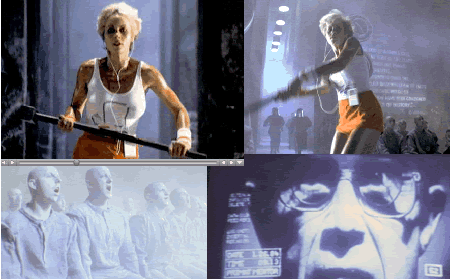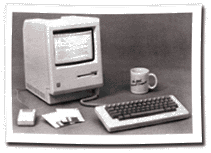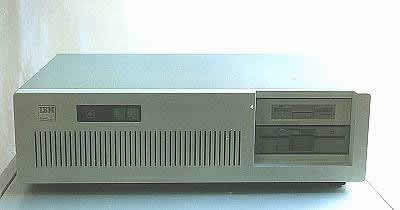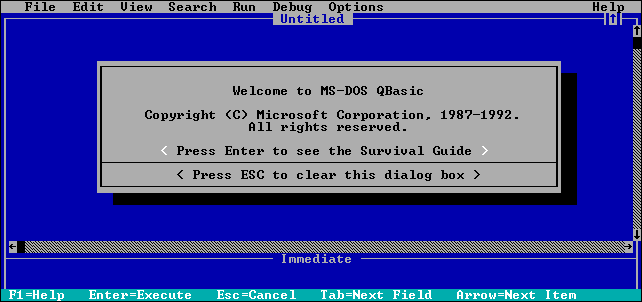|
The Industrial Era 1984 - 1985 This period still belongs to the Third
Generation of computers. |
pre history | antiquity |
pre industrial era | industrial
era
| 1947 | 1950 | 1952 | 1955 | 1958 | 1961 | 1963 | 1965 | 1969 | 1970 | 1972 | 1974 | 1976 |
| 1978 | 1980 | 1981 | 1982 | 1984 | 1986 | 1989 | 1991 | 1993 | 1994 | 1996 | 2000 | 2002 |
| Related Articles |
| Related Resources |
| pre history |
history of videogames |
![]() Apple shows
the famous Orwellian commercial, which is aired during the Superbowl(50)
, and marked the introduction of the Macintosh.
Apple shows
the famous Orwellian commercial, which is aired during the Superbowl(50)
, and marked the introduction of the Macintosh.
 |
|
|
But the superbowl advertisement nearly did not make it to the screens. ![]()
|
. |
![]() Hewlett
Packard introduces the first inkjet printer.
Hewlett
Packard introduces the first inkjet printer.
A inkjet printer injects small drops of ink on the paper in the shape of letters just like a matrix printer. Because of the special quality of the ink the small dots of ink flows together giving the letter a solid appearance.
Hewlett Packard also introduces the first laser printer (HP Laser Jet) intended for the personal computer user. Rank Xerox the inventor of this type of printer failed to recognize the potential and misses the boat here by denying the power of the personal computer market.
![]() Sinclair Research
released the QL computer (Quantum Leap)
Sinclair Research
released the QL computer (Quantum Leap)
The QL is based around the 8Mhz 68008 processor. The chip is a 32-bit processor but outside this processor the computer has still a 8-bit architecture. The machine contains 128 Kb memory and a multitasking operating system, which is very special in this period of time. But this machine was not very successful because of difficulties in the supply chain.
![]() INMOS develops
the first limited test version of a transputer.
INMOS develops
the first limited test version of a transputer.
It contains an Intel 6Mhz 80286 CPU. It supports 1 Mb of memory. It is possible to set the CPU in the so called "enhanced mode", which makes it technically possible to run programs which are larger than 640 Kb. However this mode is very difficult to use which the result that very few programs which are specially designed for the 286 CPU. Quartedeck, a software company, designed an virtual memory extender so that even programmes not designed for this enhanced mode could run in it.
|
 |
 |
In 1984 science-fiction author William Gibson coined the term "cyberspace" in his novel Neuromancer. |
![]() FIDO bulletin
Board System (BBS)(46) becomes active. This is
a network where messages and software can be exchanged on world-wide scale.
The network is divided in several zone-nodes and regional-nodes. Via these nodes
it is possible to send messages and software to other nodes in other regions
of the world. If you want to send a message you have to log into a local node
via modem. By using and electronic address of a specific region a message jumps
via several nodes to the place of destination. Within one year there will be
approximately 100 nodes available 24 hours a day.
FIDO bulletin
Board System (BBS)(46) becomes active. This is
a network where messages and software can be exchanged on world-wide scale.
The network is divided in several zone-nodes and regional-nodes. Via these nodes
it is possible to send messages and software to other nodes in other regions
of the world. If you want to send a message you have to log into a local node
via modem. By using and electronic address of a specific region a message jumps
via several nodes to the place of destination. Within one year there will be
approximately 100 nodes available 24 hours a day.
The system is more or less similar to the ARPA net launched in 1970. The big difference between ARPA and FIDO is that everyone is allowed to use FIDO. The use of the system is free of charge, only in some cases the system operator (SYSOP) asks a small membership fee. Most of the time the SYSOP is also the owner of the BBS equipment.
![]() Apr 1, Stewart
Brand and Larry Brilliant launched the Well (Whole Earth 'Lectronic Link) in
Sausalito. In La Jolla, Ca., Larry Brilliant, physician and head of Network
Technologies Int'l. in Michigan, pitched the idea for a public computer conferencing
system to Stewart Brand, publisher of the Whole Earth Catalog. Their meeting
led to the 1985 founding of "The Well" online service that operated
as a collection of conferences. It used the PicoSpan conferencing software.
In 2001 Katie Hafner authored "The Well: A Story of Love, Death and Real
Life in the Seminal Online Community."(1)
Apr 1, Stewart
Brand and Larry Brilliant launched the Well (Whole Earth 'Lectronic Link) in
Sausalito. In La Jolla, Ca., Larry Brilliant, physician and head of Network
Technologies Int'l. in Michigan, pitched the idea for a public computer conferencing
system to Stewart Brand, publisher of the Whole Earth Catalog. Their meeting
led to the 1985 founding of "The Well" online service that operated
as a collection of conferences. It used the PicoSpan conferencing software.
In 2001 Katie Hafner authored "The Well: A Story of Love, Death and Real
Life in the Seminal Online Community."(1)
|
A mouse is an input/pointing device needed when you want to work with the so called WIMP (Windows) interface on your computer. Originally is was a little square box made of wood that contained two wheels and some kind of buttons to "click" on the various elements on your screen The invention was first used on Xerox
Alto and Star computers,
for the consumer the Lisa
and later the Apple Macintosh
computers were among the first to use a device like that. Later in the 1990's the RSI(49) syndrome caused many computer workers a lot of pain. Because of that computer hardware had to be redesigned to alleviate the RSI factors. Thus a clumsy squarisch looking box became a highly ergonomical mouse that reduced the strain in using it. The mouse is still being approved upon and has taken many forms. |
![]() The
Psion 1 is considered the first personal digital assistant (PDA). The Psion
can store addresses and phone numbers, keep a calendar and includes a clock
and a calculator.
The
Psion 1 is considered the first personal digital assistant (PDA). The Psion
can store addresses and phone numbers, keep a calendar and includes a clock
and a calculator.
![]() Richard
Stallman thinks that users deserve the freedom that he believes they lost:
freedom to copy and redistribute software as well as make changes to it.
As a concequence he leaves MIT's Artificial Intelligence Lab to found the
GNU Project. The GNU project stand for free software one may copy and alter
as they want. One of the prime examples is Linux (1991), free for all to
use as one sees fit.
Richard
Stallman thinks that users deserve the freedom that he believes they lost:
freedom to copy and redistribute software as well as make changes to it.
As a concequence he leaves MIT's Artificial Intelligence Lab to found the
GNU Project. The GNU project stand for free software one may copy and alter
as they want. One of the prime examples is Linux (1991), free for all to
use as one sees fit.
![]() The Compact
Disk Read Only Memory, a k a the CD-ROM, first grew out of the audio Compact
Disk.
The Compact
Disk Read Only Memory, a k a the CD-ROM, first grew out of the audio Compact
Disk.
![]() 1 Mb of RAM
becomes a standard in 286 computers. The new 286 CPU is able to address 16 Mb
of memory and has a clock speed that varies between 8 to 20 MHz. The processor
supports 1024 colors but only 16 to 32 colors (depending on the amount of video
memory) can be displayed at once.
1 Mb of RAM
becomes a standard in 286 computers. The new 286 CPU is able to address 16 Mb
of memory and has a clock speed that varies between 8 to 20 MHz. The processor
supports 1024 colors but only 16 to 32 colors (depending on the amount of video
memory) can be displayed at once.
![]() INMOS introduces
the first Transputer, the T414. A micro processor which is especially designed
for parallel processing of data. It is the fastest 32-bit CPU at this moment:
20 million instructions per second (MIPS) and 2 million floating point calculation
per second (FLOPS).
INMOS introduces
the first Transputer, the T414. A micro processor which is especially designed
for parallel processing of data. It is the fastest 32-bit CPU at this moment:
20 million instructions per second (MIPS) and 2 million floating point calculation
per second (FLOPS).
The basic idea behind the Transputer is simple: put on a CPU some extra memory
and four fast DMA / serial communication "links" on a chip. Put these
chips in a network and let them all simultaneously (parallel) work on the same
problem.
It was only until IBM developed a expansion card containing the program language
OCCAM that made "parallel computing" more popular.
![]() Windows 1.0
released
Windows 1.0
released
Microsoft ships Windows 1.0, nearly a year later than expected. The interface
allows rudimentary pointing and clicking. Although several companies had raced
to develop point-and-click interfaces, in the end, they cede the victory to
Microsoft. However, Windows doesn't catch on widely until the introduction of
Windows 3.1 in March 1992. (6)
![]() Control Video
changes name to Quantum Computer Services
Control Video
changes name to Quantum Computer Services
An online gaming company changes its name to Quantum Computer Services. Quantum
creates online services for Apple, Commodore, and other computer manufacturers.
In 1989, the company will change its name again, this time to America Online.
(6)
![]() Microsoft announces
Excel
Microsoft announces
Excel
Microsoft unveils plans for a new spreadsheet program designed for the Apple
Macintosh. The new product, called Excel, gives the Apple a badly needed business
application. (6)
![]() The WELL launches
The WELL launches
The Whole Earth 'Lectronic Link (WELL), a California-based online company owned
by Whole Earth Catalog publisher Steward Brand, launches. The service provides
bulletin boards for online discussions and attracts a hip, intellectual crowd.
The discussion group later provides Internet services to its members. Salon.com,
an online magazine, will buy the discussion group portion of the company in
the mid-1990s. (6)
![]() The first domain
names are registered
The first domain
names are registered
Symbolics.com becomes the first registered domain (15-mar-1985) and is quickly
followed by cmu.edu, purdue.edu, ucl.edu, and others. (6)
![]() Quantum launches
Q-Link
Quantum launches
Q-Link
Quantum Computer Services launches Q-Link, an online service for users of Commodore's
Amiga computers. The company also develops AppleLink, a network for Apple users.
Quantum will later change its name to America Online. (6)
![]() The Motorola
68000 is quickly succeeded by 68010/ 68020 and 68030 processors. These kind
of chips are mainly used in computers which are more graphical orientated. Such
as: Apple Macintosh IIe and Atari ST series.
The Motorola
68000 is quickly succeeded by 68010/ 68020 and 68030 processors. These kind
of chips are mainly used in computers which are more graphical orientated. Such
as: Apple Macintosh IIe and Atari ST series.
![]() VisiCalc is
the first successful spreadsheet program in the world. Lotus Development (producer
of Lotus 1-2-3) looked at VisiCalc as one of their strongest competitors. In
the vision of "If you can’t beat them join them"(47)
Lotus bought a few years ago the VisiCalc company. As everyone expected, in
the year 1985 Lotus removed VisiCalc of the market.
VisiCalc is
the first successful spreadsheet program in the world. Lotus Development (producer
of Lotus 1-2-3) looked at VisiCalc as one of their strongest competitors. In
the vision of "If you can’t beat them join them"(47)
Lotus bought a few years ago the VisiCalc company. As everyone expected, in
the year 1985 Lotus removed VisiCalc of the market.
![]() The prototype
of the Amiga is developed by an independent company. Because a long designing
process the company has a shortage of funds to continue the project. Commodore
takes over the company and launches this year the Commodore Amiga 1000. The
Amiga caused an enormous shock among the users. The computer is so advanced
for its time that even the marketing department of Commodore did not knew what
they are up to. The computer integrated almost everything: Video, graphic and
sound chips. Also external sound and video sources could be connected to this
machine. The operating system of the Amiga was designed by Carl Sassenrath and
was also advanced for its time: multi tasking environment, graphical user interface.
Equipped with 256Kb RAM the Amiga was sold at a retail price of 1200 US$. Looking
back in time you could say that the Amiga was the first Multi Media computer.
The prototype
of the Amiga is developed by an independent company. Because a long designing
process the company has a shortage of funds to continue the project. Commodore
takes over the company and launches this year the Commodore Amiga 1000. The
Amiga caused an enormous shock among the users. The computer is so advanced
for its time that even the marketing department of Commodore did not knew what
they are up to. The computer integrated almost everything: Video, graphic and
sound chips. Also external sound and video sources could be connected to this
machine. The operating system of the Amiga was designed by Carl Sassenrath and
was also advanced for its time: multi tasking environment, graphical user interface.
Equipped with 256Kb RAM the Amiga was sold at a retail price of 1200 US$. Looking
back in time you could say that the Amiga was the first Multi Media computer.
![]() IBM develops
the first Megabit RAM.
IBM develops
the first Megabit RAM.
![]() Hewlett Packard
introduces the HP LaserJet on the market. This will become one of their most
successful products. Thanks to HP, laser printer technology becomes within reach
of smaller companies. Also the use of desktop publishing is given a big impulse.
Hewlett Packard
introduces the HP LaserJet on the market. This will become one of their most
successful products. Thanks to HP, laser printer technology becomes within reach
of smaller companies. Also the use of desktop publishing is given a big impulse.
![]() MS-DOS 3.1
supports a network environment.
MS-DOS 3.1
supports a network environment.
![]() Aldus company
introduces the first Desktop Publishing program called Page Maker.(48)
Pagemaker drives the success of the Macintosh. The page layout software launches
the desktop publishing industry virtually overnight. The software is designed
for the Apple Macintosh and was the first program that enabled a single individual
to write, make a layout and print a book or newspaper, including illustrations
on a personal computer and a printer. In 1989 the program will be published
for IBM compatible PC’s.
Aldus company
introduces the first Desktop Publishing program called Page Maker.(48)
Pagemaker drives the success of the Macintosh. The page layout software launches
the desktop publishing industry virtually overnight. The software is designed
for the Apple Macintosh and was the first program that enabled a single individual
to write, make a layout and print a book or newspaper, including illustrations
on a personal computer and a printer. In 1989 the program will be published
for IBM compatible PC’s.

![]() Intel
announced the 32-bit 80386 processor which is also downward compatible with
the 80286. Details of the CPU are: Registers, Address and Data bus are 32bit,
addressable memory of 4Gbyte, Virtual Mode which allowed Real Mode simulation
in Protected Mode. The chip contained 275.000 transistors and reached a speed
up to 8 MIPS. With this kind of speed the PC came in range of low end Main Frame
computers.
Intel
announced the 32-bit 80386 processor which is also downward compatible with
the 80286. Details of the CPU are: Registers, Address and Data bus are 32bit,
addressable memory of 4Gbyte, Virtual Mode which allowed Real Mode simulation
in Protected Mode. The chip contained 275.000 transistors and reached a speed
up to 8 MIPS. With this kind of speed the PC came in range of low end Main Frame
computers.
Amongst the first machines that used the 80368 technology were the Compaq Deskpro
386 and the IBM’s System 2. Compaq was way ahead on the development of
386 computers compared to IBM. It is therefore that the Compaq company was responsible
for the explosion in sales of 80386 computers. Compaq wanted to produce best
quality computers and accertain a leading role in computer development the price
of a Compaq computer is 30% higher than one of the competitor.
![]() MS-DOS 3.2
is made compatible for 3.5 inch micro floppies with a capacity of 720Kb.
MS-DOS 3.2
is made compatible for 3.5 inch micro floppies with a capacity of 720Kb.

![]() Microsoft's
Quick BASIC revolutionized BASIC and legitimized it as a serious development
language for the DOS environment. Quick BASIC is a compiled language. Microsoft
started to ship an interpreted version of this with each version of DOS called
GW-BASIC.
Microsoft's
Quick BASIC revolutionized BASIC and legitimized it as a serious development
language for the DOS environment. Quick BASIC is a compiled language. Microsoft
started to ship an interpreted version of this with each version of DOS called
GW-BASIC.
![]()
| Last Updated on October 25, 2004 | For suggestions please mail the editors |
Footnotes & References